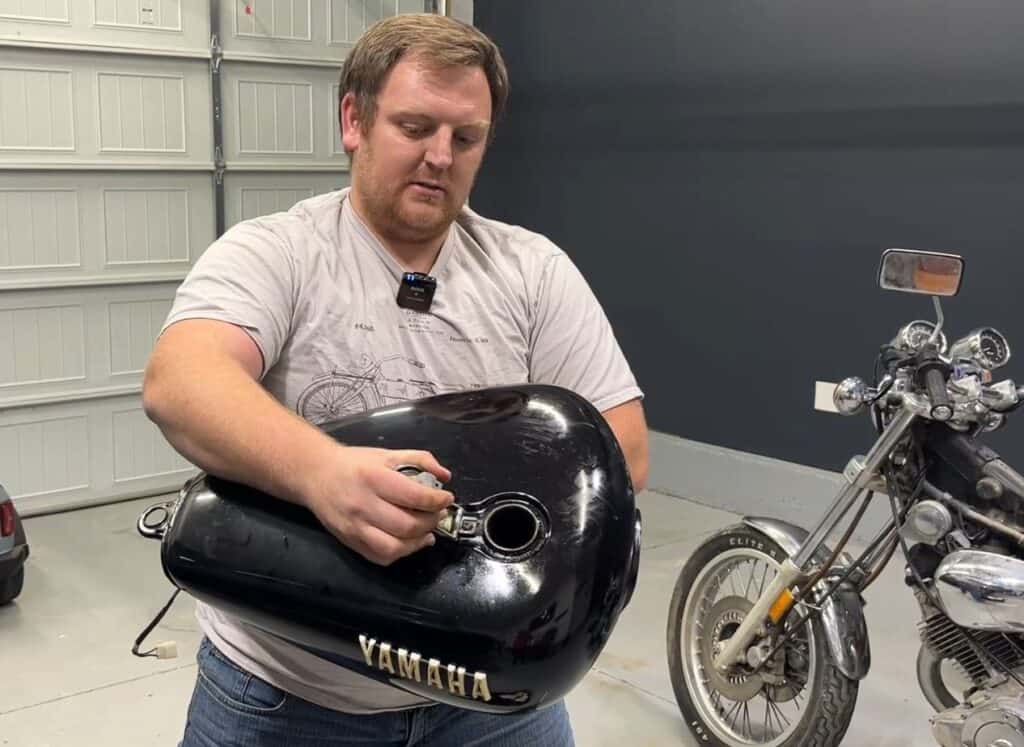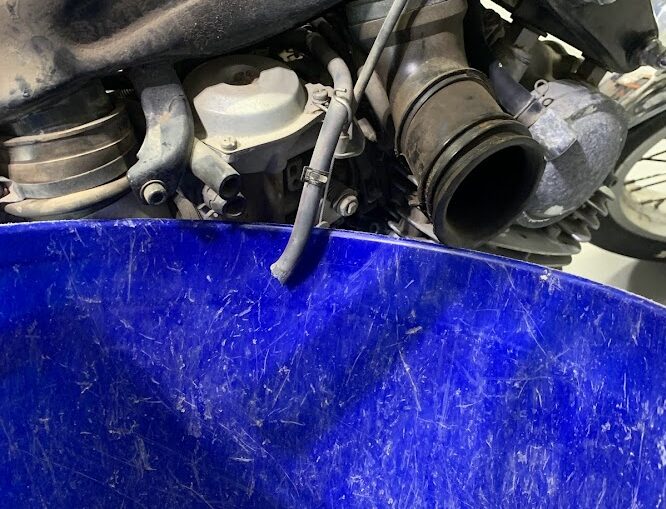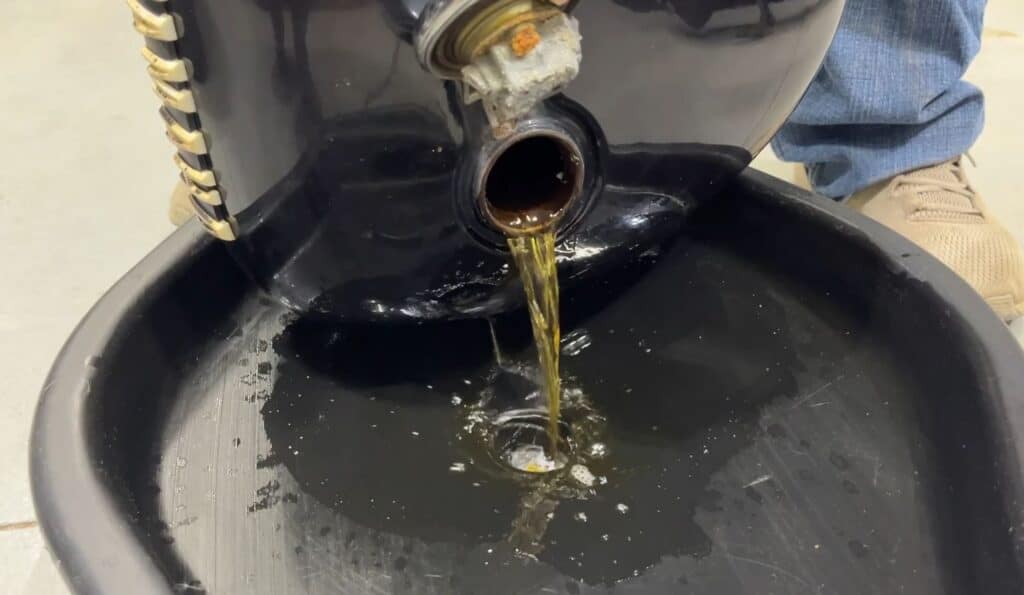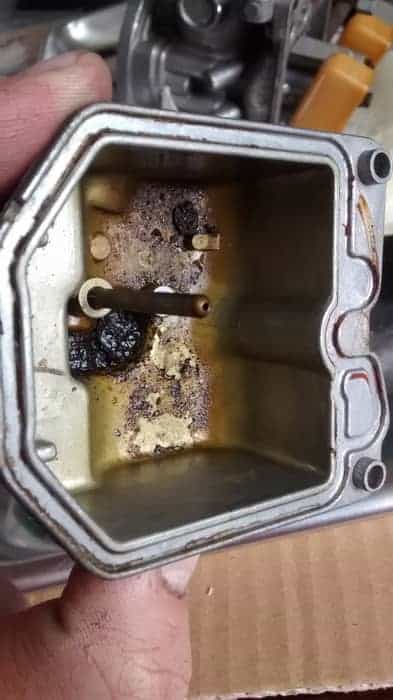
Though using gas in your motorcycle is as simple as pouring some in the tank, there can be a few problems that arise if you don’t take care of the fuel properly. As crazy as it might sound, it is possible for gas to go bad and it’s important you don’t let bad gas circulate through the system.
If you suspect you have bad gas inside your motorcycle tank, it’s best to simply start over by removing it and replacing it with fresh fuel. Doing so is a lot easier said than done though.
How do you drain bad gas from a motorcycle? There are a few ways to drain bad gas from a motorcycle. Such ways include disconnecting the fuel line from the carburetor and letting it drain into a container, using a siphon pump, or removing the gas tank completely and draining it. You’ll also need to do a thorough clean of the carburetor if you have one.
I’ve owned several motorcycles that required me to drain the gas from the entire fuel system because it had been sitting for years. I’ve become very familiar with the process and can explain exactly how to do it so it won’t cause problems for you in the future.
Draining The Bad Gas From Your Tank
Before going through the effort of removing the gas, you’ll need to first determine if the gas is bad. How to identify whether or not gas is bad will be explained in the next section. Once you determine it’s bad, there are several ways of going about getting the gas out.
The first and most simple way of draining bad gas from your motorcycle tank is through the petcocks. On the sides of your gas tank, there should be a hose that connects from the petcock down to the carburetor. This is how the gas delivers fuel to the carburetor which then gives the appropriate amount of fuel to the engine.
Make sure you are in a well ventilated area before pursing an activity like this. You’ll also need a gas can or some other container for the gas to spill into. Make sure your petcock is turned to “off” when you start. Disconnect that hose where it is connected to the carburetor. There may be a little bit of gas that drains out of it.

Place the hose so the end is inside your gas container. Next, turn your petcock to “on” or “reserve” if you have it. Gravity should work it’s magic and the gas from the tank should flow through the tube and into your container.
A much more thorough way would be to dismount the tank from the motorcycle and draining it either through the petcock holes or through the gas cap. This will require more work because you usually have to take a few other things off the motorcycle including the seat to get the tank off, but this will ensure you get everything out of it.

The next option you have is using a siphon pump that can be purchased at most hardware stores for around $15-$20. If you don’t want to mess with the petcocks or the fuel lines, this would be a good option for you.

A siphon pump works by placing one of tube ends inside the gas tank through the gas cap hole and placing the other end into your emptying container. Make sure that when you place the tube in the gas tank that it touches the very bottom and deepest part of the tank. This ensures you will get all of the gas.
There will be a pumping mechanism on the siphon pump that will siphon the gas to the container once you start pumping it. Be sure to do is slow because going too fast could cause the gas to splatter everywhere due to air bubbles (I know this from experience).
If you have a carburetor, you’ll need to get the gas out of that as well. Chances are, if you’ve been running bad gas through your fuel system, there’s residual gunk left inside the carbs that could cause fuel delivery issues.
It’s possible to clean your carbs without having to remove it from your motorcycle. See my article here on how to do so. But in this instance, I do recommend that you completely remove the carburetor and give it a good cleaning. Any small piece of gunk left over from bad gas could easily clog up the jets.
For a better visual, here’s our YouTube video that shows how to drain bad gas from a motorcycle.
How To Tell If The Gas Is Bad
There are a few simple tests you can do to ensure you’re doing the right thing for your motorcycle. First, observe how your motorcycle is running. Is it running poorly and/or having a difficult time starting up? Does it even start at all? Those are possible symptoms that your motorcycle is holding bad gas.
Next, you can do the smell test. Gas that has gone bad will be quite obvious, even to the untrained nose. Bad gas usually smells stale or sour and doesn’t really smell like it’s original scent. If your gas smells off, chances are it has gone bad.
You can also look at the color and appearance of the gas. Sometimes it’s hard to tell what the color is by looking inside the tank, so you may need to get a sample of it. Fresh gas should have a clear, clean appearance. If the gas has turned a darker color or has any clumps in it, that’s a sign it has gone bad.
Also note how long that gas has been in the tank. It only takes a few months for gas to become stale, especially if stabilizer hasn’t been added to it. See our other article here to learn more about the symptoms of bad gas in your motorcycle.
How Long Gas Can Last In A Motorcycle Tank
In a perfect world, gas would last forever in our motorcycles and it wouldn’t have to be yet another part of maintenance to worry about. When oil is refined, it is given a volatility property, meaning it vaporizes in a way that’s beneficial to your machine.
But this vaporizing happens whether or not you’re using your motorcycle. This means that over time, varnish and gum deposits will eventually start to form. If you have unstabilized gas in your gas tank, it’s possible for it to start going bad after about 30 days. This usually goes unnoticed because most motorcyclists will add new gas by then which dilutes the bad gas.

But understand that if you don’t use your motorcycle frequently, that 30 days expiration date can happen pretty quickly. Even stabilized gas can start going bad between 6 – 12 months.
So if you know you aren’t going to be using your motorcycle very often, it’s best to put in a good stabilizer in the tank and let it run through the fuel system so you don’t run into the issue of expired or spoiled gas down the road. Click here to see my article for more information about how long it takes for gas to go bad in a motorcycle.
What Bad Gas Can Do To Your Motorcycle
It’s good that you’re reading up on how to drain bad gas from your motorcycle; bad gas can have a lot of impact on it. Bad gas doesn’t necessarily ruin any parts, but it does cause a lot of frustration on your part.
Because of the gum and varnish deposits that can eventually build up in the gas, this will often cause clogging problems within the fuel system. There are tiny little holes inside a fuel injector and a carburetor. The gas needs to pass through these tiny holes to deliver the appropriate amount of fuel required for combustion to happen in the engine.
When a gel-like substance passes through these tiny holes, it often stays there and ultimately blocks the gas from being able to pass through. Because the gas cannot pass through, your motorcycle engine will not get the fuel it needs to either run appropriately or even start at all.
Again, this doesn’t necessarily cause damage to your motorcycle, it just means you have to take time to drain the gas out of the tank and clean out the fuel delivery system.
Conclusion
Draining bad gas from your motorcycle gas tank is pretty annoying, but it must be done if your motorcycle has been sitting for a while. The three methods I mentioned should do the trick, but I do highly recommend taking the tank off and draining it through the gas cap opening. This is a task simple enough for a beginner. Good luck!
